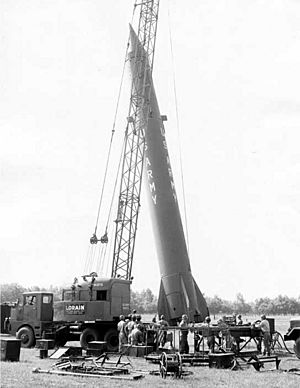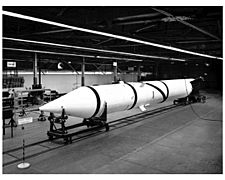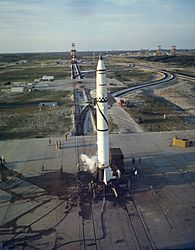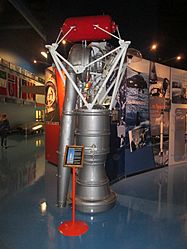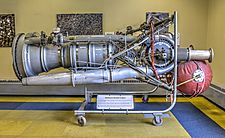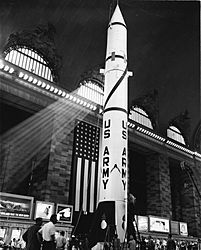PGM-11 Redstone facts for kids
The PGM-11 Redstone was the first big ballistic missile built by the United States. It was a short-range ballistic missile (SRBM), meaning it could travel shorter distances. The United States Army used it in West Germany from 1958 to 1964. It was an important part of NATO's defense during the Cold War. The Redstone was also the first U.S. missile to carry a real nuclear weapon during a test in 1958.
The Redstone missile was inspired by the German V-2 rocket. It was mainly developed by German rocket scientists who came to the U.S. after World War II. The missile used a powerful engine from Rocketdyne. This allowed it to carry the W39 warhead, which weighed about 6,900 pounds (3,130 kg), up to 175 miles (282 km). The main company that built the Redstone was Chrysler Corporation.
The Redstone missile led to the Redstone rocket family. These rockets achieved many "firsts" in the U.S. space program. For example, a Redstone rocket launched the first American astronaut into space! The Army stopped using the Redstone in 1964. It was replaced by the solid-fueled MGM-31 Pershing missile. Many leftover Redstone missiles were used for test flights and space launches. In 1967, one even launched Australia's first satellite.
Quick facts for kids SSM-A-14/M8/PGM-11 Redstone |
|
|---|---|
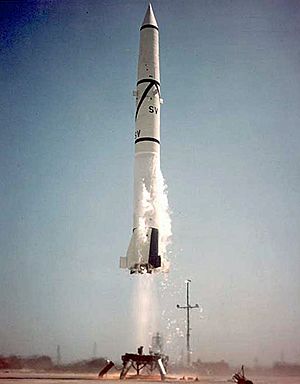
Redstone No. CC-56, Cape Canaveral, Florida, 17 September 1958
|
|
| Type |
|
| Place of origin | United States |
| Service history | |
| In service | 1958–1964 |
| Used by | United States |
| Production history | |
| Designer | Army Ballistic Missile Agency |
| Designed | 1950–1952 |
| Manufacturer | Chrysler Corporation |
| Produced | 1952–1961 |
| No. built |
|
| Variants | Block I, Block II |
| Specifications | |
| Mass | 61,207 pounds (27,763 kg) at ignition |
| Length | 69.3 feet (21.1 m) |
| Diameter | 5.83 feet (1.8 m) |
|
|
|
| Blast yield | W39 warhead, 3.8 megatons of TNT (16 PJ) |
|
|
|
| Engine | Rocketdyne North American Aviation 75–110 A-7 78,000 pounds-force (350 kN) thrust at sea level for 121 seconds |
| Payload capacity | 6,305 pounds (2,860 kg) |
| Propellant |
|
| Fuel capacity |
|
|
Operational
range |
57.5 to 201 miles 92.5 to 323.5 kilometres |
| Flight altitude | 28.4 to 58.7 miles 45.7 to 94.5 kilometres |
| Boost time | 97 seconds to 117 seconds |
| Maximum speed | Mach 5 – Mach 6 (6,100–7,400 km/h; 3,800–4,600 mph; 1.7–2.0 km/s) maximum at re-entry interface |
|
Guidance
system |
Ford Instrument Company ST-80 inertial guidance |
|
Steering
system |
Carbon jet vanes, air rudders, spatial air jet nozzles, air vanes |
| Accuracy | 300 metres (980 ft) CEP |
|
Launch
platform |
guided missile platform launcher M74 |
Contents
Developing the Redstone Missile
The Redstone missile was directly related to the German V-2 rocket. This rocket was developed by Wernher von Braun and his team of German rocket engineers. They were brought to the United States after World War II as part of Operation Paperclip.
The Army Ballistic Missile Agency (ABMA) designed the Redstone. This happened at Redstone Arsenal in Huntsville, Alabama. It was meant to be a surface-to-surface missile for the U.S. Army. The missile was named after the arsenal on April 8, 1952. The arsenal got its name from the area's red rocks and soil.
First Flights and Challenges
The first Redstone missile launched from Cape Canaveral on August 20, 1953. It flew for 80 seconds before its engine failed and it fell into the sea. The second test flight on January 27, 1954, went perfectly. The missile flew 55 miles (88.5 km) without any problems. After these first two tests, engineers improved the engine to fix issues.
The third Redstone flight on May 5 was a complete failure. The engine stopped just one second after launch. The rocket fell back onto the launch pad and exploded. After this, Major General Holger Toftoy asked Wernher von Braun why it failed. Von Braun said they didn't know yet but would study the data.
Von Braun pushed his team to make the missiles more reliable. He reportedly said, "Missile reliability will require that the target area is more dangerous than the launch area." Later test flights went much better. The Army announced the Redstone was ready for use in mid-1955. Testing then moved to larger launch pads.
End of Service
The Redstone program caused some disagreements between the Army and Air Force. They had different ideas about how to use nuclear weapons. The Army wanted smaller warheads on mobile missiles for battlefield use. The Air Force wanted large missiles that could strike targets far away.
Newer, solid-fueled missiles came along that were easier to store and launch. This made the Redstone missile outdated. Production of the Redstone ended in 1961. The Army officially stopped using the Redstone missile in 1964. It was replaced by the MGM-31 Pershing missile. All Redstone missiles in Europe were sent back to the U.S. by late 1964. In October 1964, the Redstone missile was officially retired.
How the Redstone Missile Worked
The Redstone missile could fly between 57.5 miles (92.5 km) and 201 miles (323 km). It had two main parts: a thrust unit for powered flight and a missile body for guiding the payload to the target.
During its powered flight, the Redstone burned a fuel mixture. This mixture was 75% ethyl alcohol and 25% water. It used liquid oxygen (LOX) as an oxidizer to help it burn. Later Redstones used a different fuel called Hydyne.
The missile body held the instrument compartment and the warhead. The warhead carried the payload. The missile body separated from the thrust unit about 20 to 30 seconds after the engine stopped. This timing depended on how far the target was. The missile body then continued on its path to the target. The thrust unit fell separately, landing before the target.
The nuclear-armed Redstone carried the W39 warhead. This warhead had a powerful yield of 3.8 megatons.
Building the Redstone
Chrysler Corporation was given the main contract to produce the Redstone. They built it at a factory in Warren, Michigan. This factory was once used for jet engine production. After a jet engine program was canceled, Chrysler used the facility for missile production. They started making missiles and support equipment in 1952.
Other companies helped build the Redstone:
- Rocketdyne made the rocket engines.
- Ford Instrument Company produced the guidance and control systems.
- Reynolds Metals Company built parts of the missile body.
Redstone Family of Rockets
In 1955, the Jupiter-C rocket was developed. It was an improved version of the Redstone. It had longer fuel tanks for longer burn times. It also used a new fuel called hydyne. The Jupiter C, also known as the Juno 1, launched the first successful U.S. satellite, Explorer 1, into space in 1958.
The Mercury-Redstone Launch Vehicle was another version of the Redstone. Its fuel tank was made 6 feet (1.8 m) longer. On May 5, 1961, this rocket launched Alan Shepard. He became the second person and first American in space. This rocket kept the longer fuel tanks of the Jupiter C but went back to using ethyl alcohol and water as fuel.
From 1966 to 1967, modified Redstones called Spartas were launched from Australia. This was part of a research program between the U.S., UK, and Australia. They wanted to understand how objects re-enter Earth's atmosphere. These Redstones had two extra solid fuel stages added. The U.S. gave a spare Sparta rocket to Australia. It was used to launch WRESAT, Australia's first satellite, in November 1967.
Where to See Redstone Missiles Today
Many Redstone missiles are still on display in museums and parks. Here are some places where you can see them:
- National Air and Space Museum at the Steven F. Udvar-Hazy Center, Washington, D.C.
- U.S. Space & Rocket Center, Huntsville, Alabama
- Battleship Memorial Park, Mobile, Alabama
- Air Force Space and Missile Museum, Cape Canaveral, Florida
- Kansas Cosmosphere, Hutchinson, Kansas (only the payload and aft unit)
- National Museum of Nuclear Science & History, Albuquerque, New Mexico
- White Sands Missile Range Museum, White Sands, New Mexico
- Evergreen Aviation & Space Museum, McMinnville, Oregon
- Marshall Space Flight Center, Huntsville, Alabama
- US Army Field Artillery Museum, Fort Sill, Oklahoma
- Warren, New Hampshire Historical Society
You can also see Jupiter-C rockets, which are Redstone derivatives, at:
- US Space and Rocket Center, Huntsville, Alabama
- Kennedy Space Center Visitor Complex, Merritt Island, Florida
- Marshall Space Flight Center, Huntsville, Alabama
Mercury-Redstone Launch Vehicles are on display at:
- Kennedy Space Center Visitor Complex, Merritt Island, Florida
- Air Zoo, Kalamazoo, Michigan (in storage)
- Kansas Cosmosphere, Hutchinson, Kansas
- Museum of Life + Science, Durham, North Carolina
- Parque de las Ciencias Luis A. Ferré at Bayamón, Puerto Rico
- Space Center Houston, Houston, Texas
- US Space and Rocket Center, Huntsville, Alabama
- United States Astronaut Hall of Fame, Kennedy Space Center Visitor Complex
Gallery
-
Redstone on display, Pisgah Astronomical Research Institute
-
Redstone rocket on display since 1971 at the Warren, New Hampshire Historical Society
-
Redstone missile on display in Grand Central Terminal in New York, 7 July 1957
See also
 In Spanish: PGM-11 Redstone para niños
In Spanish: PGM-11 Redstone para niños


